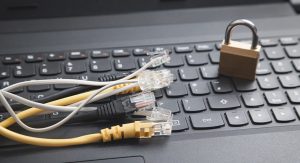Introduction
Internet security has become more important than ever before, as more and more of our life moves into the digital world. Fortunately, there are many actions you can take to make sure your computer and your data are secure when you’re browsing the internet.
The most obvious tool to help you safely navigate the online world is the lock symbol in your web browser, located beside the URL bar. But, there are other indicators that your browser can generate to notify you if a website isn’t secure and could pose a risk to your computer.
One of these indications is an error message that says: Your connection is not private.

If you choose to ignore this message, you may be facing some significant privacy risks. Let’s look at what causes this Chrome privacy error and what you can do about it.
Why Does It Say ‘Your Connection Is Not Private?’
The most common reason why people get the “your connection is not private” Google Chrome privacy error message is because your connection is, indeed, not private. It’s pretty self-explanatory.
Google Chrome checks each website before you try to access it. If it finds an insecure connection, it shows you the error message. And if you don’t have antivirus software, a VPN or other encryption software on your system, hackers will have a field day with your personal information.
Chrome regularly checks websites for digital security certificates (which must be installed on the website server) to make sure they’re compliant with privacy standards, among other things. It only shows you the “your connection is not private” message if it finds one of those certificates is missing or something else is wrong.
Note:
Keep in mind that these security certificates are proof that the website you think you’re visiting is actually the site you wanted to visit.Moreover, they help protect sensitive data such as payment credentials, passwords and other information that you’d want to keep secure on the internet.
What Causes the Privacy Error?
We covered digital security certificates in the previous section. Following that, if Chrome cannot verify the SSL certificate of any given website that the user is trying to access, it generates the error message.
This is important:
The SSL digital certificate is essential in the modern world of the internet since it keeps all of the information in transit secure and private.Of course, if the website you’re trying to visit doesn’t have an SSL digital certificate, that doesn’t necessarily mean it’s malicious.

Sometimes, the administrator of the website may allow the SSL certificate to expire. Or, maybe the people working behind the site didn’t know how to set up the certificate properly. If a trustworthy organization didn’t issue an SSL certificate to the site you want to see, then Chrome will turn on the private connection error message.
Now, let’s take a look at the different ways to fix the “your connection is not private” error message on your browser. But, before you proceed with any of the solutions below, you can always use a VPN (and antivirus software) to have more privacy—regardless of whether Google Chrome shows you a private error message indicating that your personal information is not secure.
How Do I Fix the ‘Your Connection Is Not Private’ Error in Chrome?
Refresh or Reload the Page
The golden rule to fix any browser-based website connection error is to simply reload the page. If that fails, close Google Chrome and then open it again to load your webpage one more time. It’s also possible that the website you’re trying to visit is in the process of renewing its digital SSL certificate.
Restart Your Computer
Sometimes, all you have to do is restart your computer or mobile device to get it running normally again.
Restarting the computer is a good way to clean out a temporary cache of data, fixing many issues.
This is one of the most effective ways to fix the “your connection is not private” error, as it’s used to clean out stored information from your browser.
Update Your Windows
Update your computer to the latest version of Windows or whatever platform you’re using. A fully upgraded and updated operating system means your computer has the best possible defense against anything that may compromise your personal information. Each update to your OS closes security holes that hackers can exploit in the future as they’re trying to steal your browsing data and other information.
Note:
If you don’t have the latest updates for your operating system, it might not be compatible with advanced security features like TLS v1.2 or even v1.1. Sometimes that can lead Google Chrome to present a “your connection is not private” error on your browser’s webpage.Temporarily Disable Your Antivirus Software
Antivirus programs are helpful to notify you of unsafe websites and content online. But sometimes, an antivirus program might deactivate features that a web browser may utilize for your privacy. So, try to disable your antivirus product for a few minutes and then check the site a second time to see if the matter has resolved.
Clear Chrome History
While you are at it, it’s a good idea to clean out your browser cache and cookies as well. Open Google Chrome and go to the settings menu by clicking the three vertical buttons near the top-right corner of your screen.

Then, click on More Tools.
After that, hit Clear Browsing Data.

From the new screen, look at the Time Range field and select All Time instead of Last Hour or Last 24 Hours.

Also, check all the other options such as Cached Images and Files, Cookies and Other Site Data and Browsing History.
Try Chrome’s Incognito Mode
If your browser lets you roam the internet without any history, cookies or cache, you may be able to fix the Chrome private error.
Click on the three vertical dots icon in the top-right corner of the Chrome window and then choose New Incognito Window.

Once you have the new incognito mode window open, return to the link/URL of the site you were trying to access before to see if the error is gone.
If you’re no longer getting the privacy error and the problem appears resolved in incognito mode, then that means you need to follow the previous step in the regular version of Chrome and then clean the cache.
Choose the Right Date and Time on Your Computer
 If you haven’t set up the right date and time on your computer’s settings, this can lead to the Chrome private error since the browser is unable to verify the SSL certificate of the given site. Chrome uses your machine’s date and time settings to check the expiration date of any given website’s SSL connection certificate.
If you haven’t set up the right date and time on your computer’s settings, this can lead to the Chrome private error since the browser is unable to verify the SSL certificate of the given site. Chrome uses your machine’s date and time settings to check the expiration date of any given website’s SSL connection certificate.
So, adjusting the date and time settings could likely be the answer to your problem. It’ll also help you to fix SSL connection issues.
Fix Your Connection
The Chrome privacy error can also make its way to your screen if you connect to a public WiFi connection at an airport or a restaurant. Many websites require that you agree to their terms and conditions and privacy policy before logging in. If you haven’t agreed to that, you can get the Chrome browser error.
Expired SSL Certificate Error
This problem is more common than you might think. SSL certificates do expire, and if the site administrators don’t regularly check for such things, you could see the privacy error in Google Chrome.
What If You Ignore the ‘Your Connection Is Not Private’ Google Chrome Browser Error and Move Ahead?
Google Chrome has started to give users the choice to ignore the “your connection is not private” error and proceed to the Advanced button below the message to visit the site, even though it may have an SSL certificate error.

Before we list the two steps you’ll need to take, we’ll note that you should only proceed past the error if you know and trust the website you’re trying to visit. Even then, know that none of your data would be private.
And if you’re on a public WiFi internet connection, there’s even more of a risk that your information could be exposed to the wrong people on the same network.

First, you should disconnect from any public WiFi network and switch to a private WiFi network. Then, click the Advanced button below the “your connection is not private” Chrome browser error page. Finally, click the button that says, “Proceed to Website.”
This “fix” does not truly resolve the error in Google Chrome, but it does get you the access you need.
Website SSL Certificate Fix
SSL certificates expire after a set time. To fix this, you can try using special WordPress plugins or free certificate sources such as Let’s Encrypt. Contact your hosting company for a free SSL certificate and check if they offer one.
Once you’ve logged in to your web hosting account, go to the Control Panel and then to the Security tab. From there, click the option that says free SSL Certificate. Turn on the option to enable the SSL certificate.
Pro Tip:
Specific steps in this process may differ depending on the hosting service you’re using. You can also purchase the SSL certificate from a web hosting service like Godaddy.Or, you can install two plugins to solve the problem. Here are the steps:
- Sign in to your WordPress website.
- From the dashboard, choose the option that says Plugins.
- Then, hit Add New.
- Use the text box next to the Search Plugin option to input the text: SSL Plugin. From the results page, click on Really Simple SSL and then hit Install Now.
- Then, activate Really Simple SSL by clicking the activate button.
For an additional plugin:
- Go to the Admin Dashboard.
- Hit Plugins.
- Click Add New.
- Use the search box in the top-right corner of the Add Plugins page to search for SSL Insecure Content Fixer.
- Click the top result and hit Install Now.
- Activate by clicking the relevant button.
And that should be it.
Conclusion
Fixing the Google Chrome Browser Private error is easy once you know the steps you have to take. For any questions, use the comments section below.
